Wild Harvest Skin: Strategic Supply Chain Design and Management
VerifiedAdded on 2023/04/08
|21
|3747
|57
Report
AI Summary
This report provides a comprehensive analysis of Wild Harvest Skin's supply chain, a fictitious Australian skincare company, focusing on both upstream and downstream operations. It identifies first, second, and third-tier suppliers based on ABC inventory analysis and discusses challenges like increasing fuel costs and technological expenses, suggesting alternatives such as bulk purchasing and outsourcing. The report also examines customer value, performance dimensions like profit generation, fuel cost ratio, customer satisfaction, and current ratio, along with core competencies and value creation within the supply chain. Furthermore, it addresses supply management, logistics, quality, production capacity, inventory management, and information system issues, considering the potential impact of disruptive changes like AI and circular economy. The report concludes with recommendations for changes to the original supply chain design to enhance efficiency and sustainability. The document is available on Desklib, a platform offering a wide range of study tools and solved assignments.
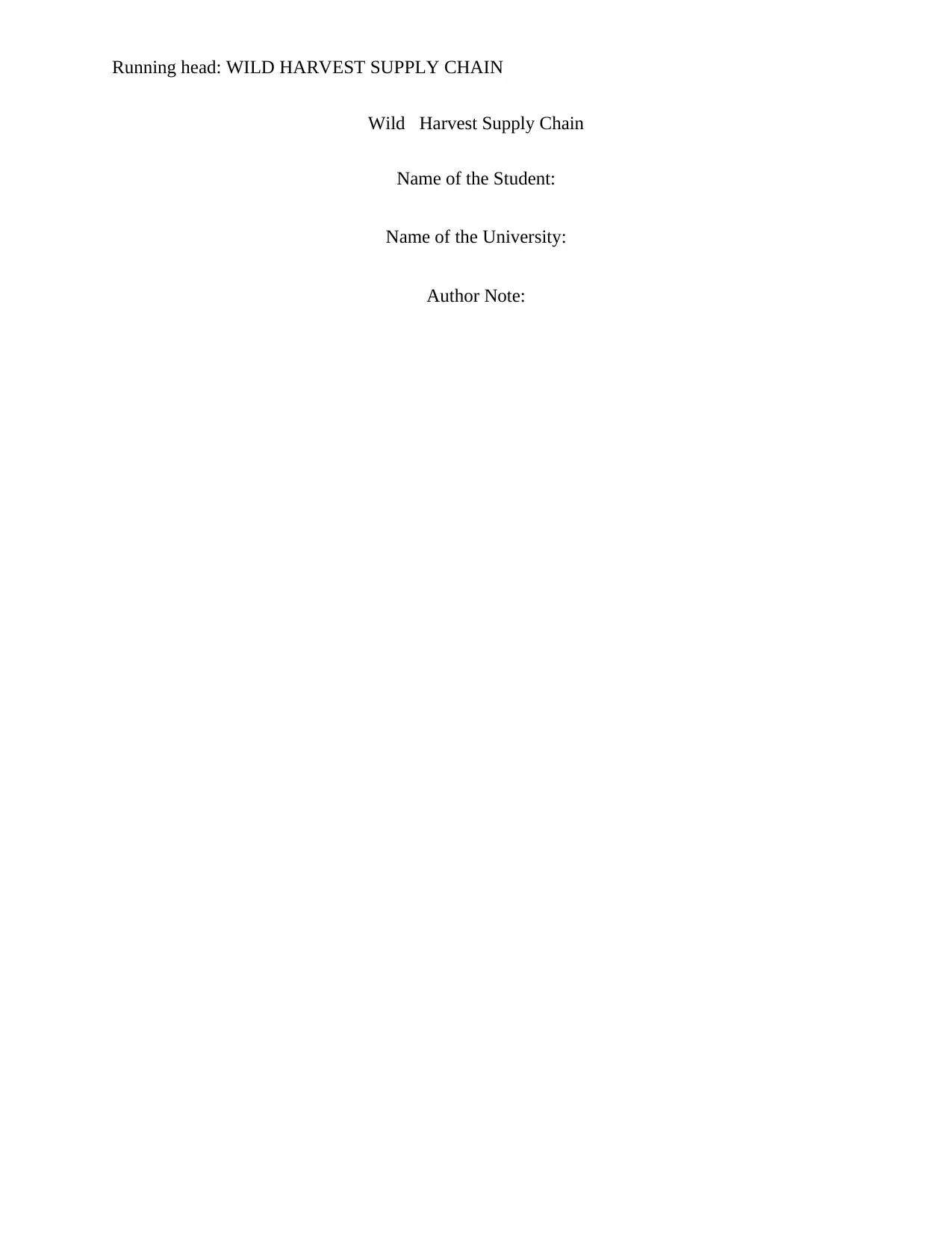
Running head: WILD HARVEST SUPPLY CHAIN
Wild Harvest Supply Chain
Name of the Student:
Name of the University:
Author Note:
Wild Harvest Supply Chain
Name of the Student:
Name of the University:
Author Note:
Paraphrase This Document
Need a fresh take? Get an instant paraphrase of this document with our AI Paraphraser
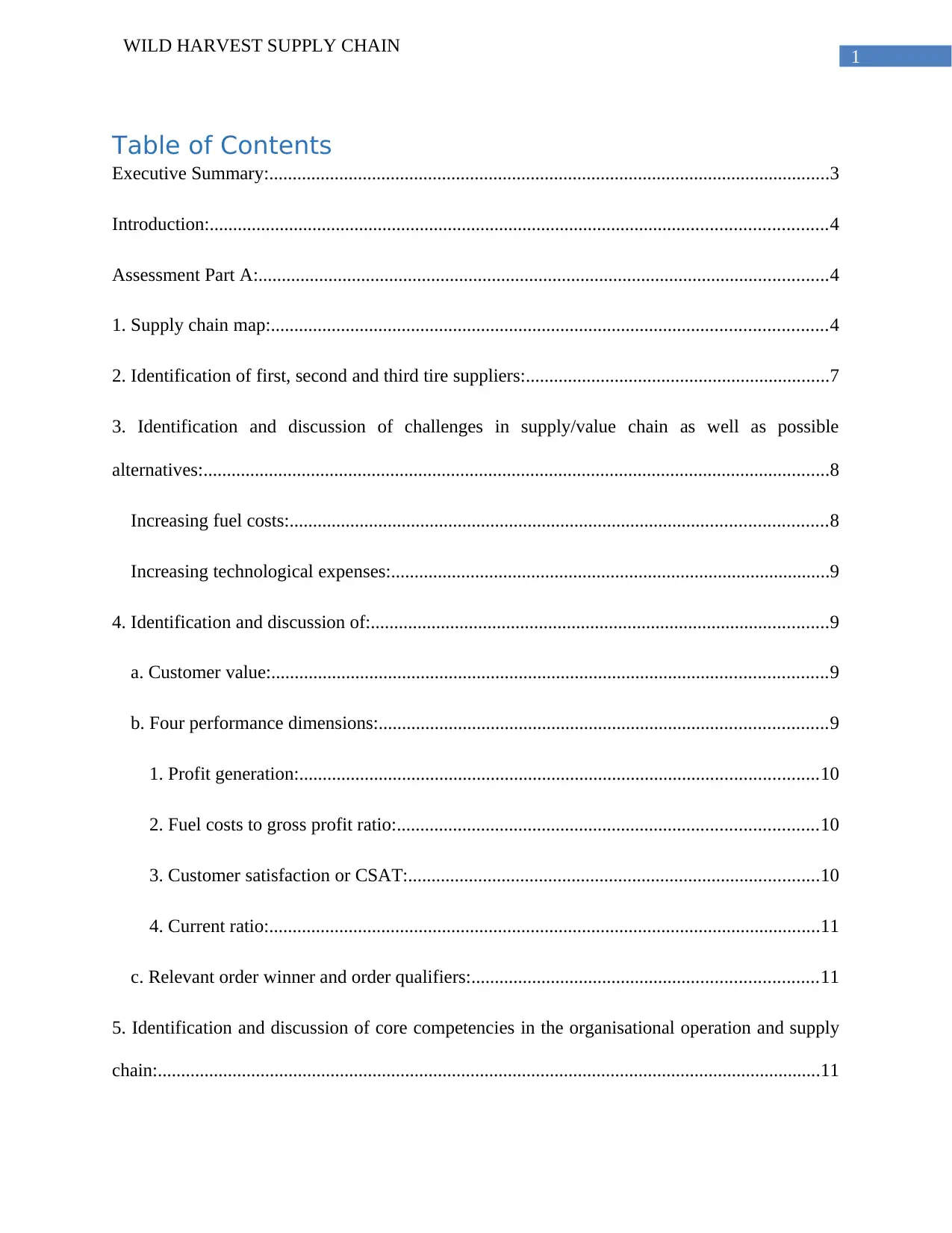
1
WILD HARVEST SUPPLY CHAIN
Table of Contents
Executive Summary:........................................................................................................................3
Introduction:....................................................................................................................................4
Assessment Part A:..........................................................................................................................4
1. Supply chain map:.......................................................................................................................4
2. Identification of first, second and third tire suppliers:.................................................................7
3. Identification and discussion of challenges in supply/value chain as well as possible
alternatives:......................................................................................................................................8
Increasing fuel costs:...................................................................................................................8
Increasing technological expenses:..............................................................................................9
4. Identification and discussion of:..................................................................................................9
a. Customer value:.......................................................................................................................9
b. Four performance dimensions:................................................................................................9
1. Profit generation:...............................................................................................................10
2. Fuel costs to gross profit ratio:..........................................................................................10
3. Customer satisfaction or CSAT:........................................................................................10
4. Current ratio:......................................................................................................................11
c. Relevant order winner and order qualifiers:..........................................................................11
5. Identification and discussion of core competencies in the organisational operation and supply
chain:..............................................................................................................................................11
WILD HARVEST SUPPLY CHAIN
Table of Contents
Executive Summary:........................................................................................................................3
Introduction:....................................................................................................................................4
Assessment Part A:..........................................................................................................................4
1. Supply chain map:.......................................................................................................................4
2. Identification of first, second and third tire suppliers:.................................................................7
3. Identification and discussion of challenges in supply/value chain as well as possible
alternatives:......................................................................................................................................8
Increasing fuel costs:...................................................................................................................8
Increasing technological expenses:..............................................................................................9
4. Identification and discussion of:..................................................................................................9
a. Customer value:.......................................................................................................................9
b. Four performance dimensions:................................................................................................9
1. Profit generation:...............................................................................................................10
2. Fuel costs to gross profit ratio:..........................................................................................10
3. Customer satisfaction or CSAT:........................................................................................10
4. Current ratio:......................................................................................................................11
c. Relevant order winner and order qualifiers:..........................................................................11
5. Identification and discussion of core competencies in the organisational operation and supply
chain:..............................................................................................................................................11
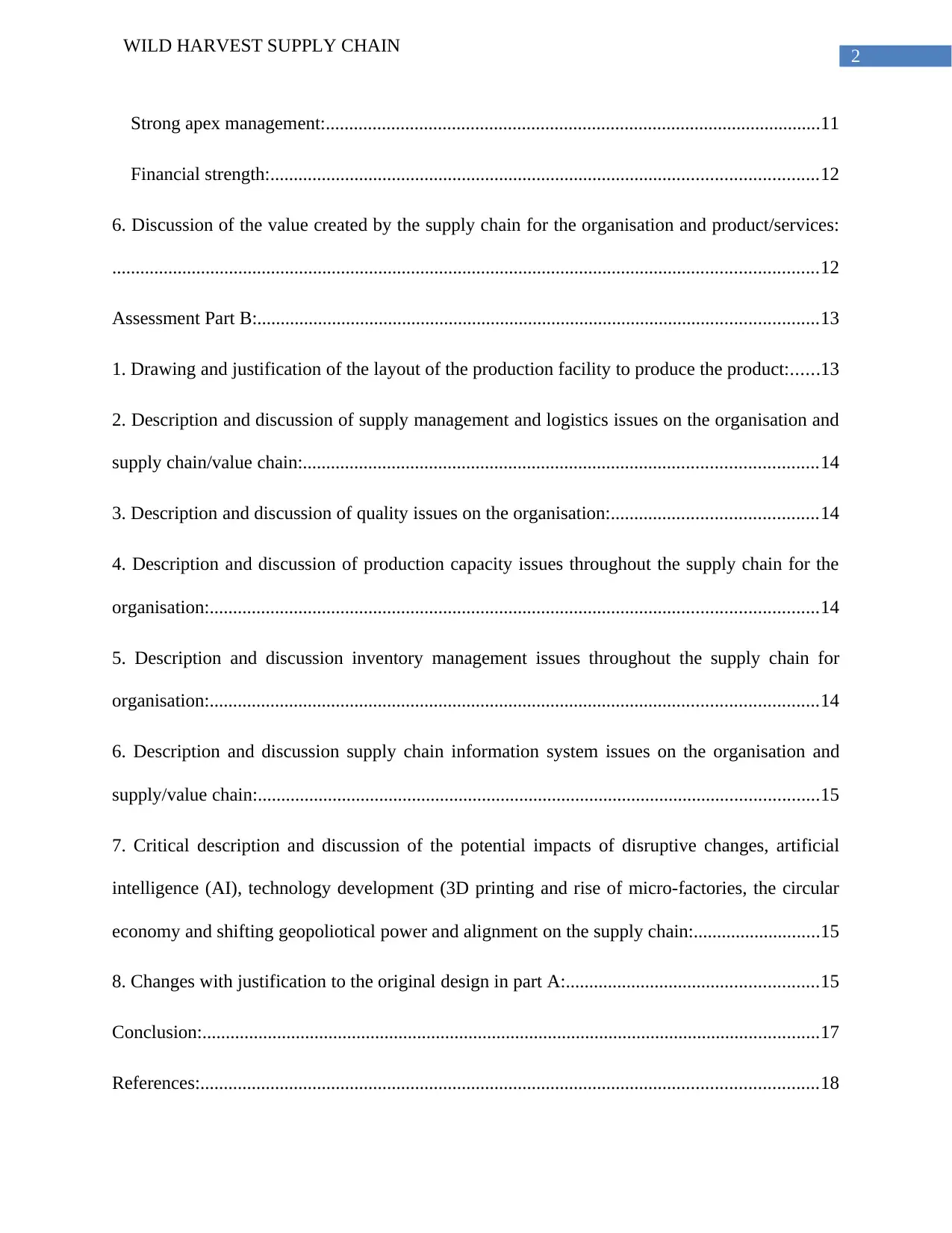
2
WILD HARVEST SUPPLY CHAIN
Strong apex management:..........................................................................................................11
Financial strength:.....................................................................................................................12
6. Discussion of the value created by the supply chain for the organisation and product/services:
.......................................................................................................................................................12
Assessment Part B:........................................................................................................................13
1. Drawing and justification of the layout of the production facility to produce the product:......13
2. Description and discussion of supply management and logistics issues on the organisation and
supply chain/value chain:..............................................................................................................14
3. Description and discussion of quality issues on the organisation:............................................14
4. Description and discussion of production capacity issues throughout the supply chain for the
organisation:..................................................................................................................................14
5. Description and discussion inventory management issues throughout the supply chain for
organisation:..................................................................................................................................14
6. Description and discussion supply chain information system issues on the organisation and
supply/value chain:........................................................................................................................15
7. Critical description and discussion of the potential impacts of disruptive changes, artificial
intelligence (AI), technology development (3D printing and rise of micro-factories, the circular
economy and shifting geopoliotical power and alignment on the supply chain:...........................15
8. Changes with justification to the original design in part A:......................................................15
Conclusion:....................................................................................................................................17
References:....................................................................................................................................18
WILD HARVEST SUPPLY CHAIN
Strong apex management:..........................................................................................................11
Financial strength:.....................................................................................................................12
6. Discussion of the value created by the supply chain for the organisation and product/services:
.......................................................................................................................................................12
Assessment Part B:........................................................................................................................13
1. Drawing and justification of the layout of the production facility to produce the product:......13
2. Description and discussion of supply management and logistics issues on the organisation and
supply chain/value chain:..............................................................................................................14
3. Description and discussion of quality issues on the organisation:............................................14
4. Description and discussion of production capacity issues throughout the supply chain for the
organisation:..................................................................................................................................14
5. Description and discussion inventory management issues throughout the supply chain for
organisation:..................................................................................................................................14
6. Description and discussion supply chain information system issues on the organisation and
supply/value chain:........................................................................................................................15
7. Critical description and discussion of the potential impacts of disruptive changes, artificial
intelligence (AI), technology development (3D printing and rise of micro-factories, the circular
economy and shifting geopoliotical power and alignment on the supply chain:...........................15
8. Changes with justification to the original design in part A:......................................................15
Conclusion:....................................................................................................................................17
References:....................................................................................................................................18
⊘ This is a preview!⊘
Do you want full access?
Subscribe today to unlock all pages.

Trusted by 1+ million students worldwide
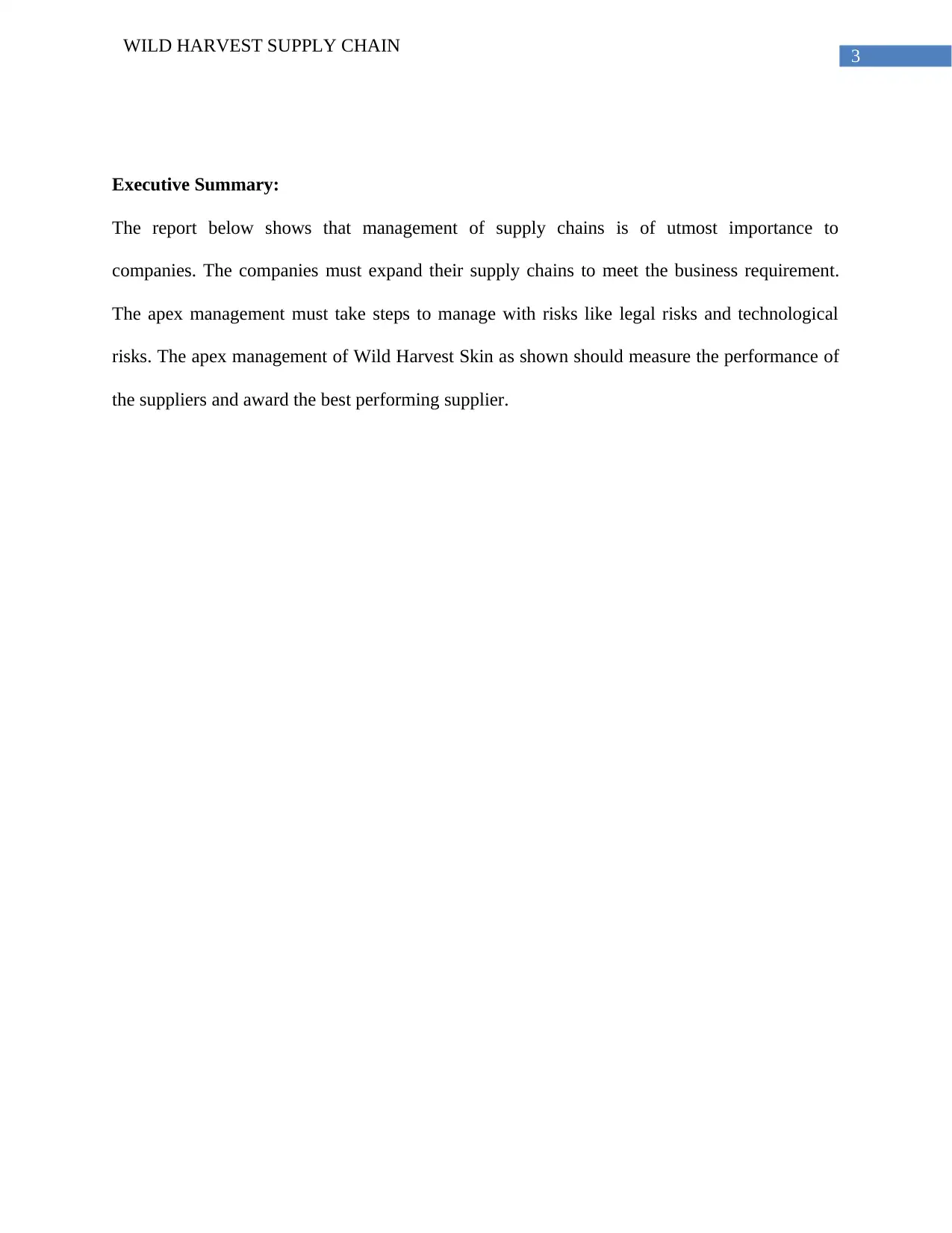
3
WILD HARVEST SUPPLY CHAIN
Executive Summary:
The report below shows that management of supply chains is of utmost importance to
companies. The companies must expand their supply chains to meet the business requirement.
The apex management must take steps to manage with risks like legal risks and technological
risks. The apex management of Wild Harvest Skin as shown should measure the performance of
the suppliers and award the best performing supplier.
WILD HARVEST SUPPLY CHAIN
Executive Summary:
The report below shows that management of supply chains is of utmost importance to
companies. The companies must expand their supply chains to meet the business requirement.
The apex management must take steps to manage with risks like legal risks and technological
risks. The apex management of Wild Harvest Skin as shown should measure the performance of
the suppliers and award the best performing supplier.
Paraphrase This Document
Need a fresh take? Get an instant paraphrase of this document with our AI Paraphraser
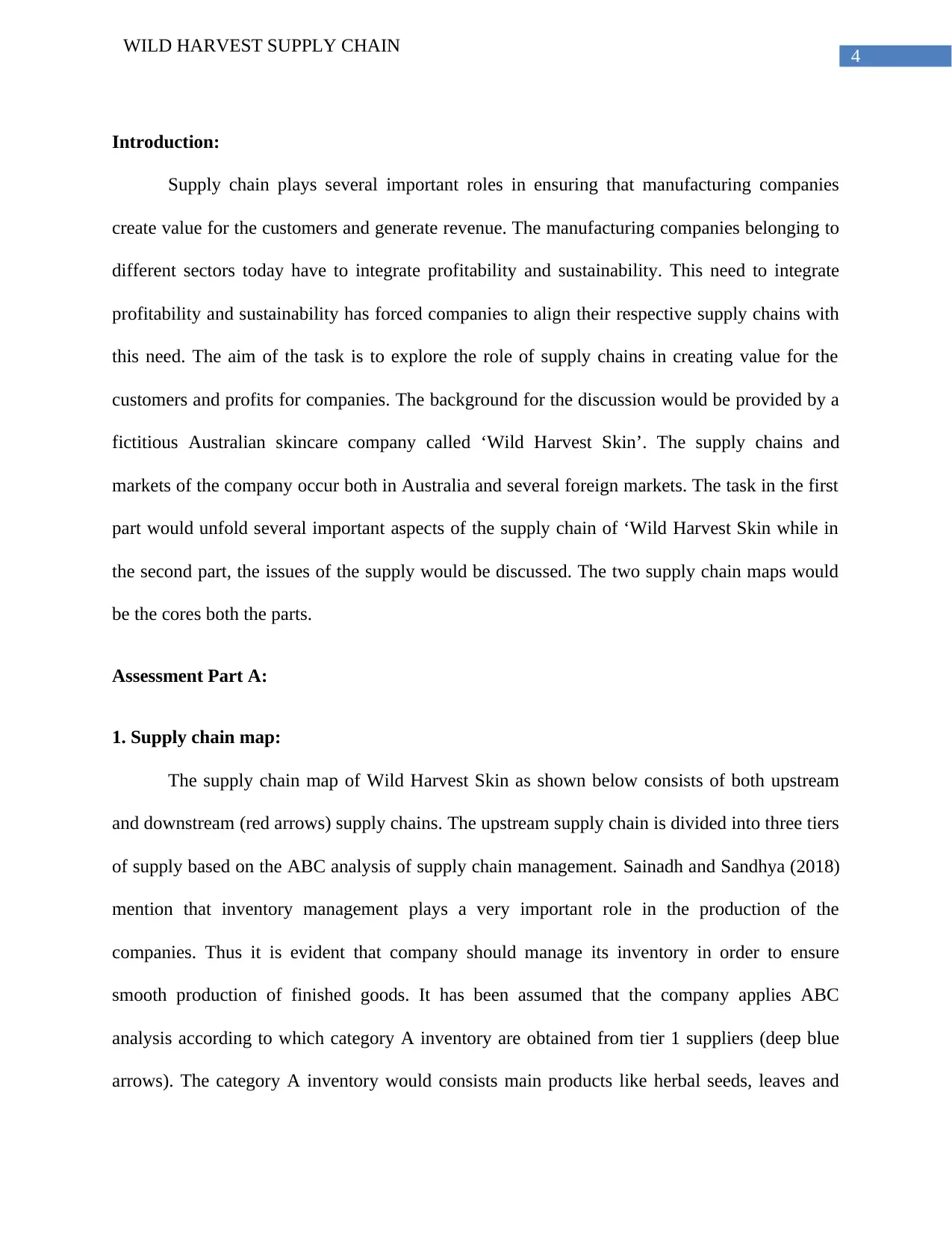
4
WILD HARVEST SUPPLY CHAIN
Introduction:
Supply chain plays several important roles in ensuring that manufacturing companies
create value for the customers and generate revenue. The manufacturing companies belonging to
different sectors today have to integrate profitability and sustainability. This need to integrate
profitability and sustainability has forced companies to align their respective supply chains with
this need. The aim of the task is to explore the role of supply chains in creating value for the
customers and profits for companies. The background for the discussion would be provided by a
fictitious Australian skincare company called ‘Wild Harvest Skin’. The supply chains and
markets of the company occur both in Australia and several foreign markets. The task in the first
part would unfold several important aspects of the supply chain of ‘Wild Harvest Skin while in
the second part, the issues of the supply would be discussed. The two supply chain maps would
be the cores both the parts.
Assessment Part A:
1. Supply chain map:
The supply chain map of Wild Harvest Skin as shown below consists of both upstream
and downstream (red arrows) supply chains. The upstream supply chain is divided into three tiers
of supply based on the ABC analysis of supply chain management. Sainadh and Sandhya (2018)
mention that inventory management plays a very important role in the production of the
companies. Thus it is evident that company should manage its inventory in order to ensure
smooth production of finished goods. It has been assumed that the company applies ABC
analysis according to which category A inventory are obtained from tier 1 suppliers (deep blue
arrows). The category A inventory would consists main products like herbal seeds, leaves and
WILD HARVEST SUPPLY CHAIN
Introduction:
Supply chain plays several important roles in ensuring that manufacturing companies
create value for the customers and generate revenue. The manufacturing companies belonging to
different sectors today have to integrate profitability and sustainability. This need to integrate
profitability and sustainability has forced companies to align their respective supply chains with
this need. The aim of the task is to explore the role of supply chains in creating value for the
customers and profits for companies. The background for the discussion would be provided by a
fictitious Australian skincare company called ‘Wild Harvest Skin’. The supply chains and
markets of the company occur both in Australia and several foreign markets. The task in the first
part would unfold several important aspects of the supply chain of ‘Wild Harvest Skin while in
the second part, the issues of the supply would be discussed. The two supply chain maps would
be the cores both the parts.
Assessment Part A:
1. Supply chain map:
The supply chain map of Wild Harvest Skin as shown below consists of both upstream
and downstream (red arrows) supply chains. The upstream supply chain is divided into three tiers
of supply based on the ABC analysis of supply chain management. Sainadh and Sandhya (2018)
mention that inventory management plays a very important role in the production of the
companies. Thus it is evident that company should manage its inventory in order to ensure
smooth production of finished goods. It has been assumed that the company applies ABC
analysis according to which category A inventory are obtained from tier 1 suppliers (deep blue
arrows). The category A inventory would consists main products like herbal seeds, leaves and
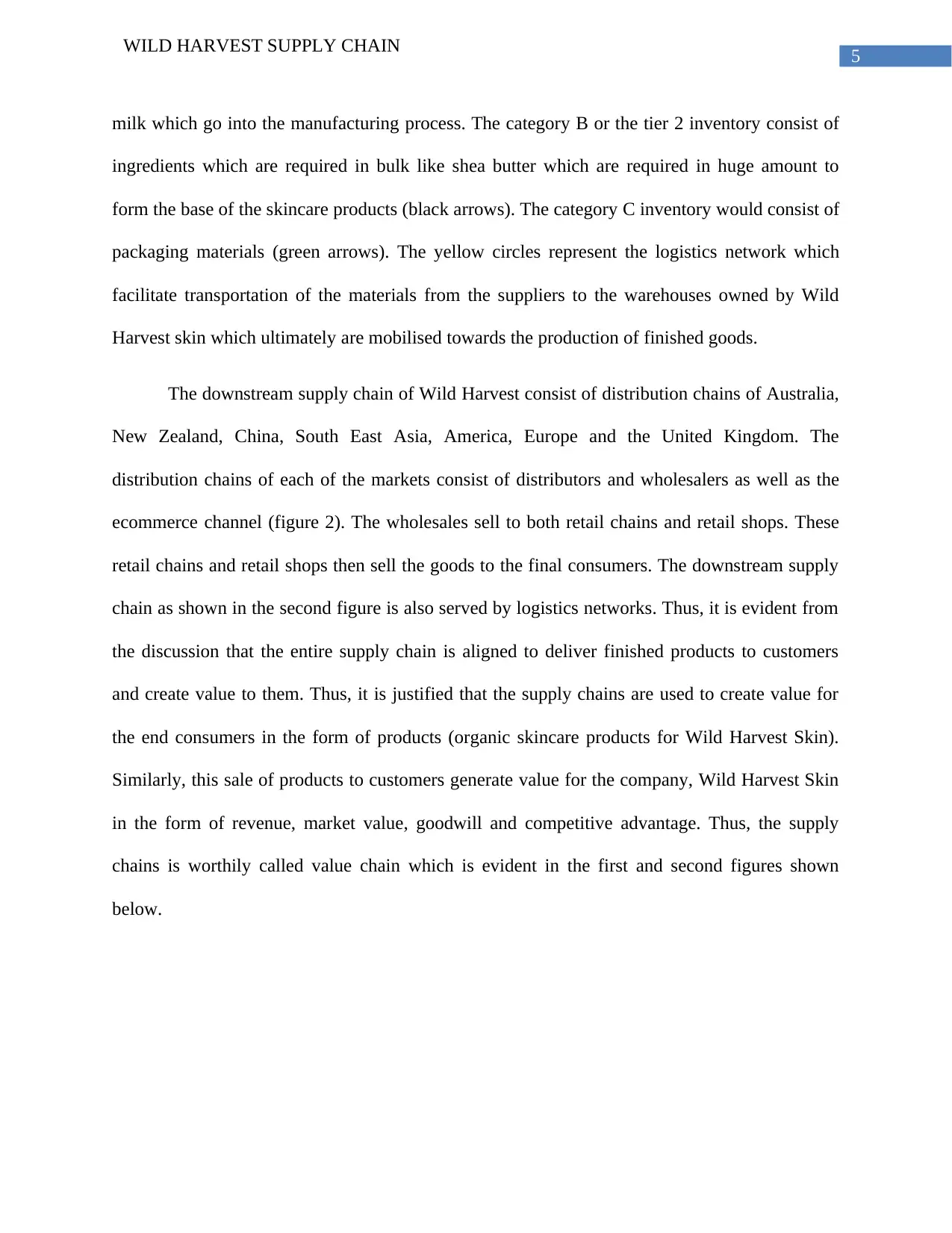
5
WILD HARVEST SUPPLY CHAIN
milk which go into the manufacturing process. The category B or the tier 2 inventory consist of
ingredients which are required in bulk like shea butter which are required in huge amount to
form the base of the skincare products (black arrows). The category C inventory would consist of
packaging materials (green arrows). The yellow circles represent the logistics network which
facilitate transportation of the materials from the suppliers to the warehouses owned by Wild
Harvest skin which ultimately are mobilised towards the production of finished goods.
The downstream supply chain of Wild Harvest consist of distribution chains of Australia,
New Zealand, China, South East Asia, America, Europe and the United Kingdom. The
distribution chains of each of the markets consist of distributors and wholesalers as well as the
ecommerce channel (figure 2). The wholesales sell to both retail chains and retail shops. These
retail chains and retail shops then sell the goods to the final consumers. The downstream supply
chain as shown in the second figure is also served by logistics networks. Thus, it is evident from
the discussion that the entire supply chain is aligned to deliver finished products to customers
and create value to them. Thus, it is justified that the supply chains are used to create value for
the end consumers in the form of products (organic skincare products for Wild Harvest Skin).
Similarly, this sale of products to customers generate value for the company, Wild Harvest Skin
in the form of revenue, market value, goodwill and competitive advantage. Thus, the supply
chains is worthily called value chain which is evident in the first and second figures shown
below.
WILD HARVEST SUPPLY CHAIN
milk which go into the manufacturing process. The category B or the tier 2 inventory consist of
ingredients which are required in bulk like shea butter which are required in huge amount to
form the base of the skincare products (black arrows). The category C inventory would consist of
packaging materials (green arrows). The yellow circles represent the logistics network which
facilitate transportation of the materials from the suppliers to the warehouses owned by Wild
Harvest skin which ultimately are mobilised towards the production of finished goods.
The downstream supply chain of Wild Harvest consist of distribution chains of Australia,
New Zealand, China, South East Asia, America, Europe and the United Kingdom. The
distribution chains of each of the markets consist of distributors and wholesalers as well as the
ecommerce channel (figure 2). The wholesales sell to both retail chains and retail shops. These
retail chains and retail shops then sell the goods to the final consumers. The downstream supply
chain as shown in the second figure is also served by logistics networks. Thus, it is evident from
the discussion that the entire supply chain is aligned to deliver finished products to customers
and create value to them. Thus, it is justified that the supply chains are used to create value for
the end consumers in the form of products (organic skincare products for Wild Harvest Skin).
Similarly, this sale of products to customers generate value for the company, Wild Harvest Skin
in the form of revenue, market value, goodwill and competitive advantage. Thus, the supply
chains is worthily called value chain which is evident in the first and second figures shown
below.
⊘ This is a preview!⊘
Do you want full access?
Subscribe today to unlock all pages.

Trusted by 1+ million students worldwide
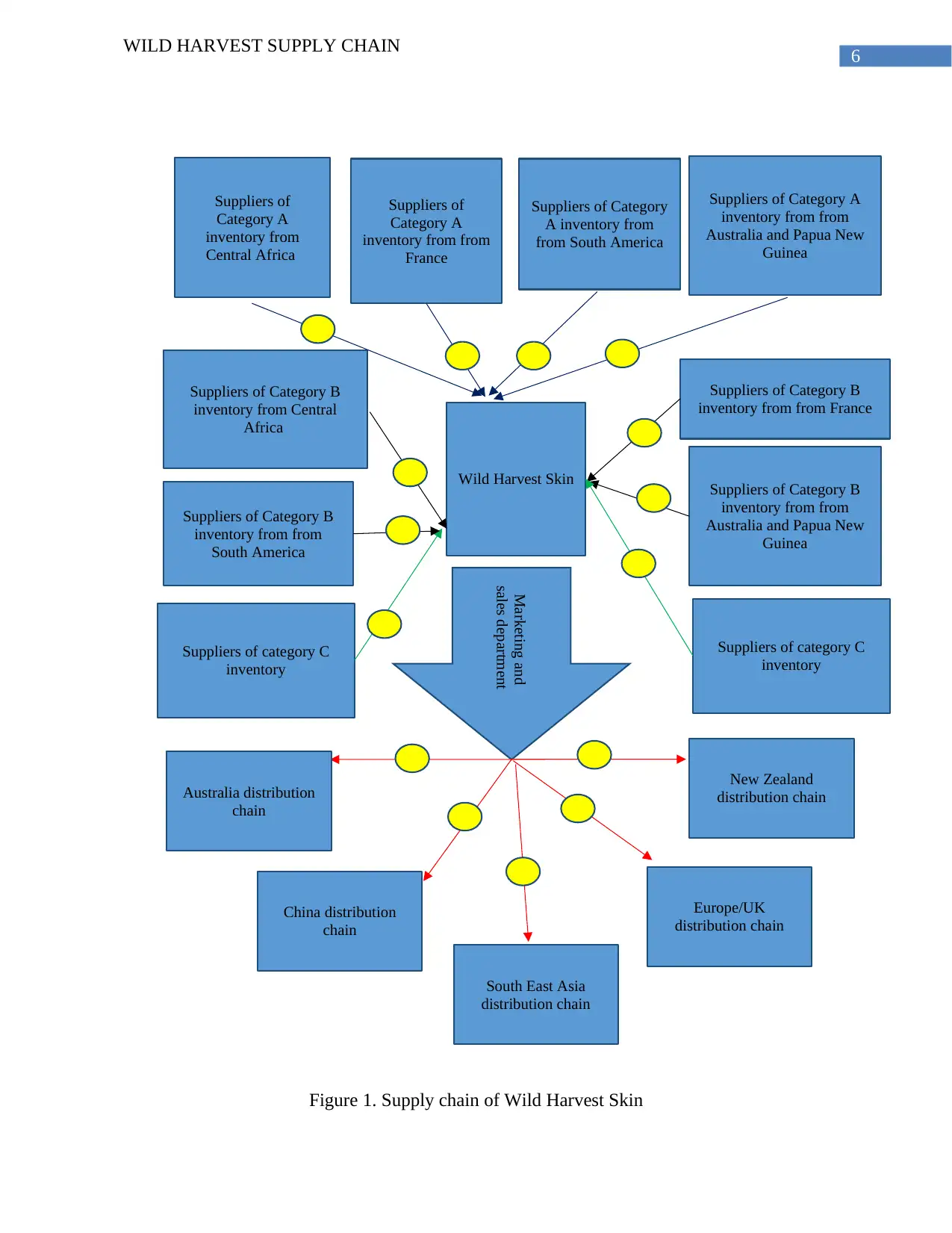
6
WILD HARVEST SUPPLY CHAIN
Suppliers of
Category A
inventory from
Central Africa
Suppliers of
Category A
inventory from from
France
Suppliers of Category
A inventory from
from South America
Suppliers of Category A
inventory from from
Australia and Papua New
Guinea
Suppliers of Category B
inventory from Central
Africa
Suppliers of Category B
inventory from from France
Suppliers of Category B
inventory from from
South America
Suppliers of Category B
inventory from from
Australia and Papua New
Guinea
Suppliers of category C
inventory
Suppliers of category C
inventory
Wild Harvest Skin
Marketing and
sales department
Australia distribution
chain
New Zealand
distribution chain
China distribution
chain
South East Asia
distribution chain
Europe/UK
distribution chain
Figure 1. Supply chain of Wild Harvest Skin
WILD HARVEST SUPPLY CHAIN
Suppliers of
Category A
inventory from
Central Africa
Suppliers of
Category A
inventory from from
France
Suppliers of Category
A inventory from
from South America
Suppliers of Category A
inventory from from
Australia and Papua New
Guinea
Suppliers of Category B
inventory from Central
Africa
Suppliers of Category B
inventory from from France
Suppliers of Category B
inventory from from
South America
Suppliers of Category B
inventory from from
Australia and Papua New
Guinea
Suppliers of category C
inventory
Suppliers of category C
inventory
Wild Harvest Skin
Marketing and
sales department
Australia distribution
chain
New Zealand
distribution chain
China distribution
chain
South East Asia
distribution chain
Europe/UK
distribution chain
Figure 1. Supply chain of Wild Harvest Skin
Paraphrase This Document
Need a fresh take? Get an instant paraphrase of this document with our AI Paraphraser
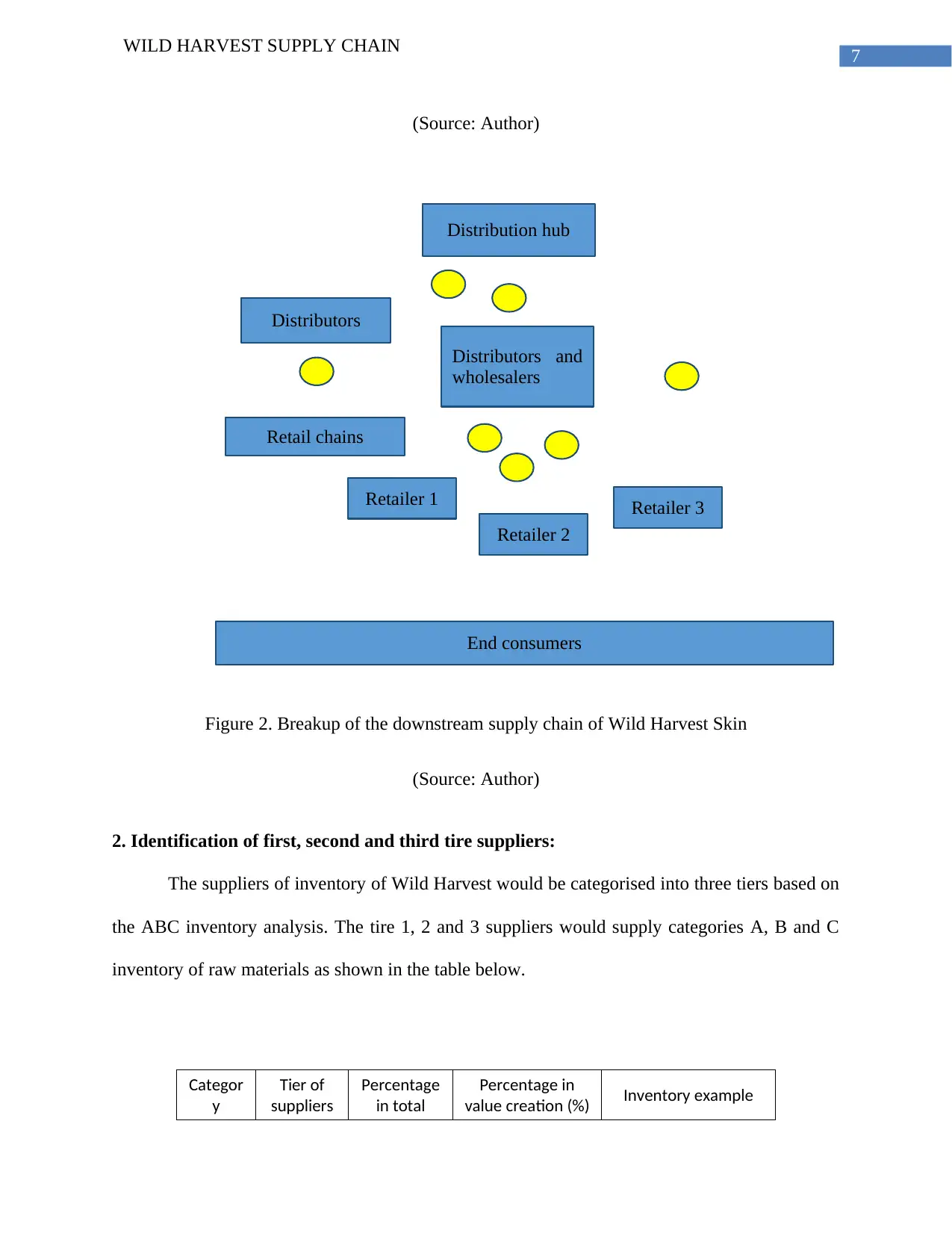
7
WILD HARVEST SUPPLY CHAIN
Distribution hub
Distributors
Distributors and
wholesalers
Retailer 1
Retailer 2
Retailer 3
Retail chains
End consumers
(Source: Author)
Figure 2. Breakup of the downstream supply chain of Wild Harvest Skin
(Source: Author)
2. Identification of first, second and third tire suppliers:
The suppliers of inventory of Wild Harvest would be categorised into three tiers based on
the ABC inventory analysis. The tire 1, 2 and 3 suppliers would supply categories A, B and C
inventory of raw materials as shown in the table below.
Categor
y
Tier of
suppliers
Percentage
in total
Percentage in
value creation (%) Inventory example
WILD HARVEST SUPPLY CHAIN
Distribution hub
Distributors
Distributors and
wholesalers
Retailer 1
Retailer 2
Retailer 3
Retail chains
End consumers
(Source: Author)
Figure 2. Breakup of the downstream supply chain of Wild Harvest Skin
(Source: Author)
2. Identification of first, second and third tire suppliers:
The suppliers of inventory of Wild Harvest would be categorised into three tiers based on
the ABC inventory analysis. The tire 1, 2 and 3 suppliers would supply categories A, B and C
inventory of raw materials as shown in the table below.
Categor
y
Tier of
suppliers
Percentage
in total
Percentage in
value creation (%) Inventory example
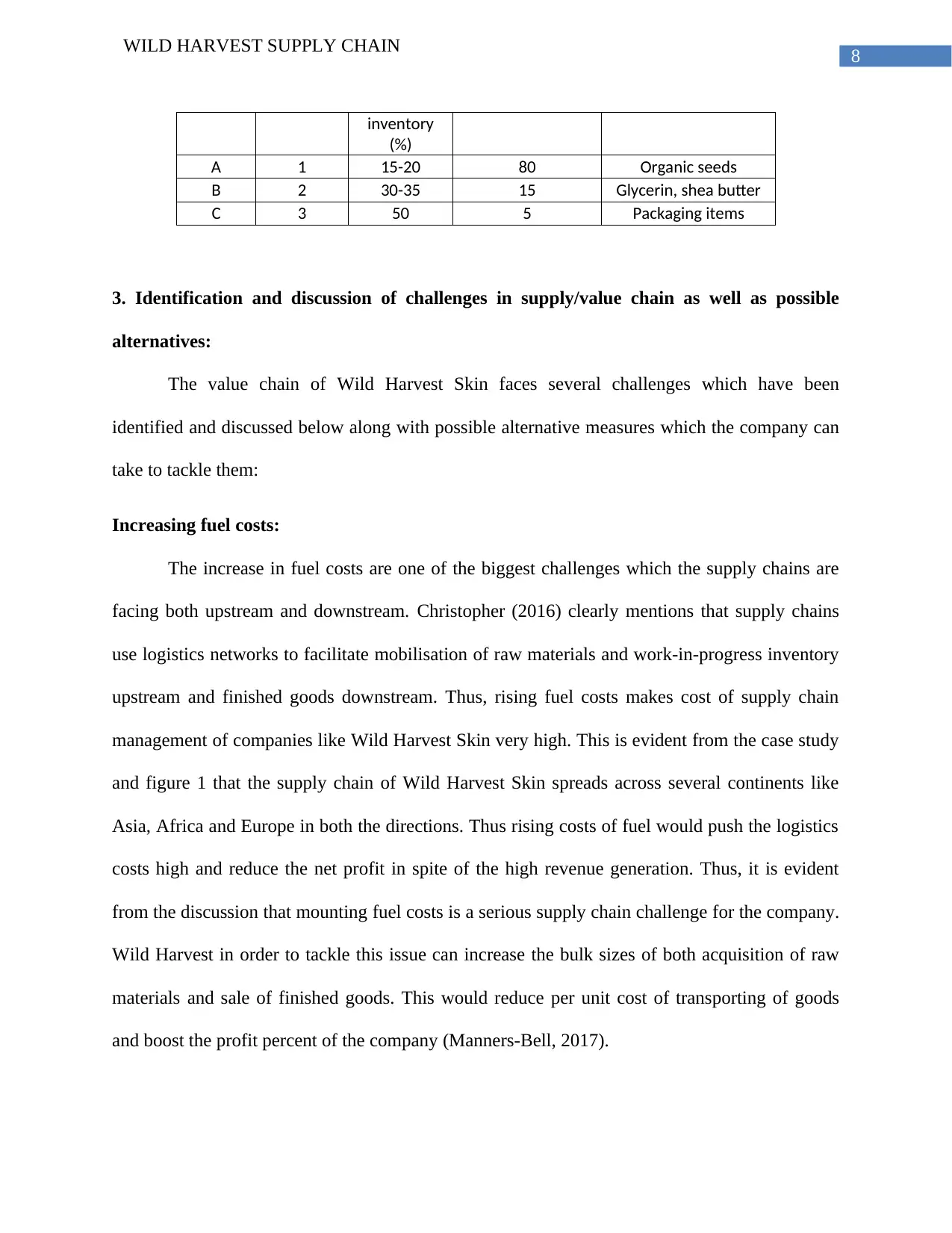
8
WILD HARVEST SUPPLY CHAIN
inventory
(%)
A 1 15-20 80 Organic seeds
B 2 30-35 15 Glycerin, shea butter
C 3 50 5 Packaging items
3. Identification and discussion of challenges in supply/value chain as well as possible
alternatives:
The value chain of Wild Harvest Skin faces several challenges which have been
identified and discussed below along with possible alternative measures which the company can
take to tackle them:
Increasing fuel costs:
The increase in fuel costs are one of the biggest challenges which the supply chains are
facing both upstream and downstream. Christopher (2016) clearly mentions that supply chains
use logistics networks to facilitate mobilisation of raw materials and work-in-progress inventory
upstream and finished goods downstream. Thus, rising fuel costs makes cost of supply chain
management of companies like Wild Harvest Skin very high. This is evident from the case study
and figure 1 that the supply chain of Wild Harvest Skin spreads across several continents like
Asia, Africa and Europe in both the directions. Thus rising costs of fuel would push the logistics
costs high and reduce the net profit in spite of the high revenue generation. Thus, it is evident
from the discussion that mounting fuel costs is a serious supply chain challenge for the company.
Wild Harvest in order to tackle this issue can increase the bulk sizes of both acquisition of raw
materials and sale of finished goods. This would reduce per unit cost of transporting of goods
and boost the profit percent of the company (Manners-Bell, 2017).
WILD HARVEST SUPPLY CHAIN
inventory
(%)
A 1 15-20 80 Organic seeds
B 2 30-35 15 Glycerin, shea butter
C 3 50 5 Packaging items
3. Identification and discussion of challenges in supply/value chain as well as possible
alternatives:
The value chain of Wild Harvest Skin faces several challenges which have been
identified and discussed below along with possible alternative measures which the company can
take to tackle them:
Increasing fuel costs:
The increase in fuel costs are one of the biggest challenges which the supply chains are
facing both upstream and downstream. Christopher (2016) clearly mentions that supply chains
use logistics networks to facilitate mobilisation of raw materials and work-in-progress inventory
upstream and finished goods downstream. Thus, rising fuel costs makes cost of supply chain
management of companies like Wild Harvest Skin very high. This is evident from the case study
and figure 1 that the supply chain of Wild Harvest Skin spreads across several continents like
Asia, Africa and Europe in both the directions. Thus rising costs of fuel would push the logistics
costs high and reduce the net profit in spite of the high revenue generation. Thus, it is evident
from the discussion that mounting fuel costs is a serious supply chain challenge for the company.
Wild Harvest in order to tackle this issue can increase the bulk sizes of both acquisition of raw
materials and sale of finished goods. This would reduce per unit cost of transporting of goods
and boost the profit percent of the company (Manners-Bell, 2017).
⊘ This is a preview!⊘
Do you want full access?
Subscribe today to unlock all pages.

Trusted by 1+ million students worldwide
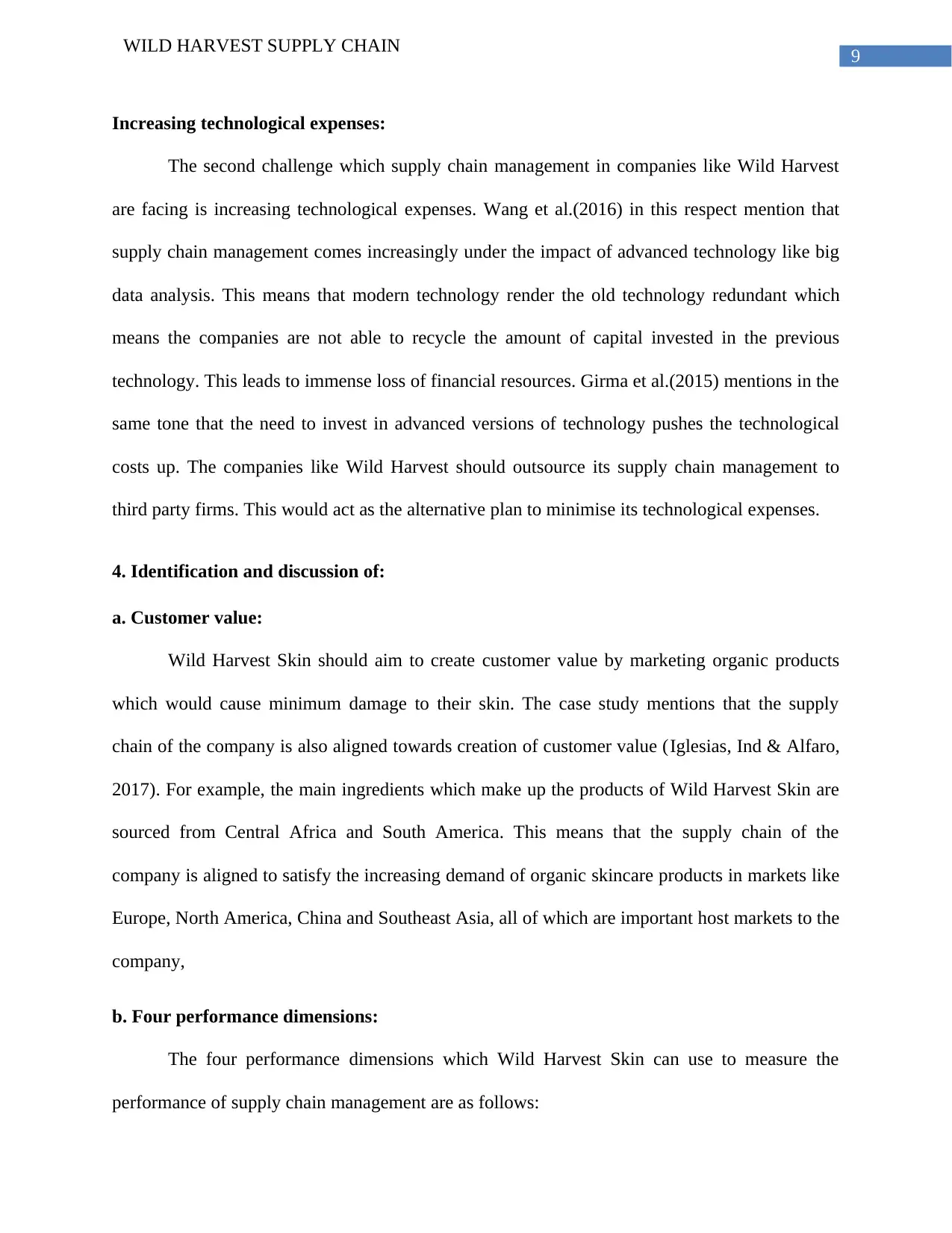
9
WILD HARVEST SUPPLY CHAIN
Increasing technological expenses:
The second challenge which supply chain management in companies like Wild Harvest
are facing is increasing technological expenses. Wang et al.(2016) in this respect mention that
supply chain management comes increasingly under the impact of advanced technology like big
data analysis. This means that modern technology render the old technology redundant which
means the companies are not able to recycle the amount of capital invested in the previous
technology. This leads to immense loss of financial resources. Girma et al.(2015) mentions in the
same tone that the need to invest in advanced versions of technology pushes the technological
costs up. The companies like Wild Harvest should outsource its supply chain management to
third party firms. This would act as the alternative plan to minimise its technological expenses.
4. Identification and discussion of:
a. Customer value:
Wild Harvest Skin should aim to create customer value by marketing organic products
which would cause minimum damage to their skin. The case study mentions that the supply
chain of the company is also aligned towards creation of customer value (Iglesias, Ind & Alfaro,
2017). For example, the main ingredients which make up the products of Wild Harvest Skin are
sourced from Central Africa and South America. This means that the supply chain of the
company is aligned to satisfy the increasing demand of organic skincare products in markets like
Europe, North America, China and Southeast Asia, all of which are important host markets to the
company,
b. Four performance dimensions:
The four performance dimensions which Wild Harvest Skin can use to measure the
performance of supply chain management are as follows:
WILD HARVEST SUPPLY CHAIN
Increasing technological expenses:
The second challenge which supply chain management in companies like Wild Harvest
are facing is increasing technological expenses. Wang et al.(2016) in this respect mention that
supply chain management comes increasingly under the impact of advanced technology like big
data analysis. This means that modern technology render the old technology redundant which
means the companies are not able to recycle the amount of capital invested in the previous
technology. This leads to immense loss of financial resources. Girma et al.(2015) mentions in the
same tone that the need to invest in advanced versions of technology pushes the technological
costs up. The companies like Wild Harvest should outsource its supply chain management to
third party firms. This would act as the alternative plan to minimise its technological expenses.
4. Identification and discussion of:
a. Customer value:
Wild Harvest Skin should aim to create customer value by marketing organic products
which would cause minimum damage to their skin. The case study mentions that the supply
chain of the company is also aligned towards creation of customer value (Iglesias, Ind & Alfaro,
2017). For example, the main ingredients which make up the products of Wild Harvest Skin are
sourced from Central Africa and South America. This means that the supply chain of the
company is aligned to satisfy the increasing demand of organic skincare products in markets like
Europe, North America, China and Southeast Asia, all of which are important host markets to the
company,
b. Four performance dimensions:
The four performance dimensions which Wild Harvest Skin can use to measure the
performance of supply chain management are as follows:
Paraphrase This Document
Need a fresh take? Get an instant paraphrase of this document with our AI Paraphraser
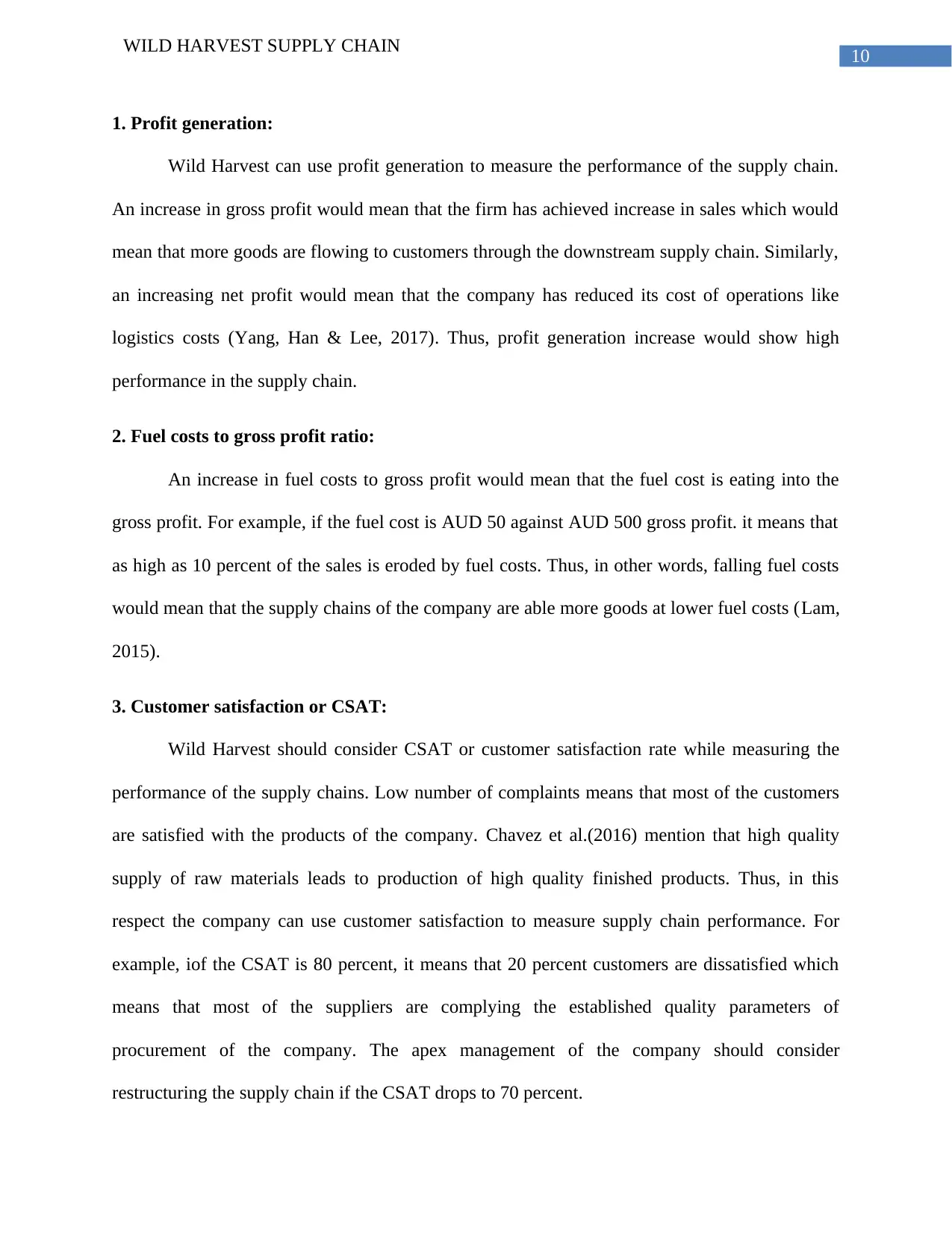
10
WILD HARVEST SUPPLY CHAIN
1. Profit generation:
Wild Harvest can use profit generation to measure the performance of the supply chain.
An increase in gross profit would mean that the firm has achieved increase in sales which would
mean that more goods are flowing to customers through the downstream supply chain. Similarly,
an increasing net profit would mean that the company has reduced its cost of operations like
logistics costs (Yang, Han & Lee, 2017). Thus, profit generation increase would show high
performance in the supply chain.
2. Fuel costs to gross profit ratio:
An increase in fuel costs to gross profit would mean that the fuel cost is eating into the
gross profit. For example, if the fuel cost is AUD 50 against AUD 500 gross profit. it means that
as high as 10 percent of the sales is eroded by fuel costs. Thus, in other words, falling fuel costs
would mean that the supply chains of the company are able more goods at lower fuel costs (Lam,
2015).
3. Customer satisfaction or CSAT:
Wild Harvest should consider CSAT or customer satisfaction rate while measuring the
performance of the supply chains. Low number of complaints means that most of the customers
are satisfied with the products of the company. Chavez et al.(2016) mention that high quality
supply of raw materials leads to production of high quality finished products. Thus, in this
respect the company can use customer satisfaction to measure supply chain performance. For
example, iof the CSAT is 80 percent, it means that 20 percent customers are dissatisfied which
means that most of the suppliers are complying the established quality parameters of
procurement of the company. The apex management of the company should consider
restructuring the supply chain if the CSAT drops to 70 percent.
WILD HARVEST SUPPLY CHAIN
1. Profit generation:
Wild Harvest can use profit generation to measure the performance of the supply chain.
An increase in gross profit would mean that the firm has achieved increase in sales which would
mean that more goods are flowing to customers through the downstream supply chain. Similarly,
an increasing net profit would mean that the company has reduced its cost of operations like
logistics costs (Yang, Han & Lee, 2017). Thus, profit generation increase would show high
performance in the supply chain.
2. Fuel costs to gross profit ratio:
An increase in fuel costs to gross profit would mean that the fuel cost is eating into the
gross profit. For example, if the fuel cost is AUD 50 against AUD 500 gross profit. it means that
as high as 10 percent of the sales is eroded by fuel costs. Thus, in other words, falling fuel costs
would mean that the supply chains of the company are able more goods at lower fuel costs (Lam,
2015).
3. Customer satisfaction or CSAT:
Wild Harvest should consider CSAT or customer satisfaction rate while measuring the
performance of the supply chains. Low number of complaints means that most of the customers
are satisfied with the products of the company. Chavez et al.(2016) mention that high quality
supply of raw materials leads to production of high quality finished products. Thus, in this
respect the company can use customer satisfaction to measure supply chain performance. For
example, iof the CSAT is 80 percent, it means that 20 percent customers are dissatisfied which
means that most of the suppliers are complying the established quality parameters of
procurement of the company. The apex management of the company should consider
restructuring the supply chain if the CSAT drops to 70 percent.
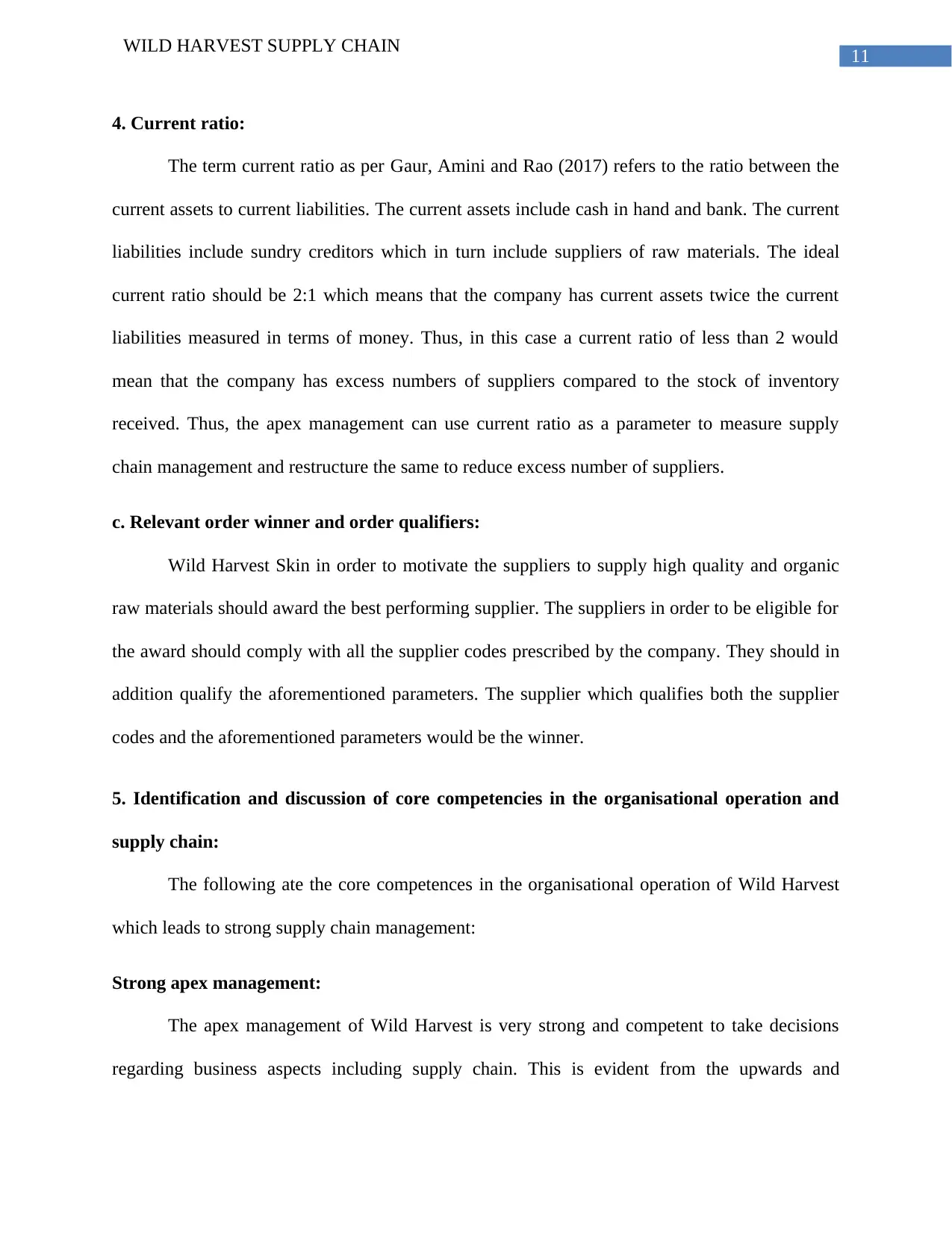
11
WILD HARVEST SUPPLY CHAIN
4. Current ratio:
The term current ratio as per Gaur, Amini and Rao (2017) refers to the ratio between the
current assets to current liabilities. The current assets include cash in hand and bank. The current
liabilities include sundry creditors which in turn include suppliers of raw materials. The ideal
current ratio should be 2:1 which means that the company has current assets twice the current
liabilities measured in terms of money. Thus, in this case a current ratio of less than 2 would
mean that the company has excess numbers of suppliers compared to the stock of inventory
received. Thus, the apex management can use current ratio as a parameter to measure supply
chain management and restructure the same to reduce excess number of suppliers.
c. Relevant order winner and order qualifiers:
Wild Harvest Skin in order to motivate the suppliers to supply high quality and organic
raw materials should award the best performing supplier. The suppliers in order to be eligible for
the award should comply with all the supplier codes prescribed by the company. They should in
addition qualify the aforementioned parameters. The supplier which qualifies both the supplier
codes and the aforementioned parameters would be the winner.
5. Identification and discussion of core competencies in the organisational operation and
supply chain:
The following ate the core competences in the organisational operation of Wild Harvest
which leads to strong supply chain management:
Strong apex management:
The apex management of Wild Harvest is very strong and competent to take decisions
regarding business aspects including supply chain. This is evident from the upwards and
WILD HARVEST SUPPLY CHAIN
4. Current ratio:
The term current ratio as per Gaur, Amini and Rao (2017) refers to the ratio between the
current assets to current liabilities. The current assets include cash in hand and bank. The current
liabilities include sundry creditors which in turn include suppliers of raw materials. The ideal
current ratio should be 2:1 which means that the company has current assets twice the current
liabilities measured in terms of money. Thus, in this case a current ratio of less than 2 would
mean that the company has excess numbers of suppliers compared to the stock of inventory
received. Thus, the apex management can use current ratio as a parameter to measure supply
chain management and restructure the same to reduce excess number of suppliers.
c. Relevant order winner and order qualifiers:
Wild Harvest Skin in order to motivate the suppliers to supply high quality and organic
raw materials should award the best performing supplier. The suppliers in order to be eligible for
the award should comply with all the supplier codes prescribed by the company. They should in
addition qualify the aforementioned parameters. The supplier which qualifies both the supplier
codes and the aforementioned parameters would be the winner.
5. Identification and discussion of core competencies in the organisational operation and
supply chain:
The following ate the core competences in the organisational operation of Wild Harvest
which leads to strong supply chain management:
Strong apex management:
The apex management of Wild Harvest is very strong and competent to take decisions
regarding business aspects including supply chain. This is evident from the upwards and
⊘ This is a preview!⊘
Do you want full access?
Subscribe today to unlock all pages.

Trusted by 1+ million students worldwide
1 out of 21
Related Documents
Your All-in-One AI-Powered Toolkit for Academic Success.
+13062052269
info@desklib.com
Available 24*7 on WhatsApp / Email
![[object Object]](/_next/static/media/star-bottom.7253800d.svg)
Unlock your academic potential
Copyright © 2020–2025 A2Z Services. All Rights Reserved. Developed and managed by ZUCOL.





